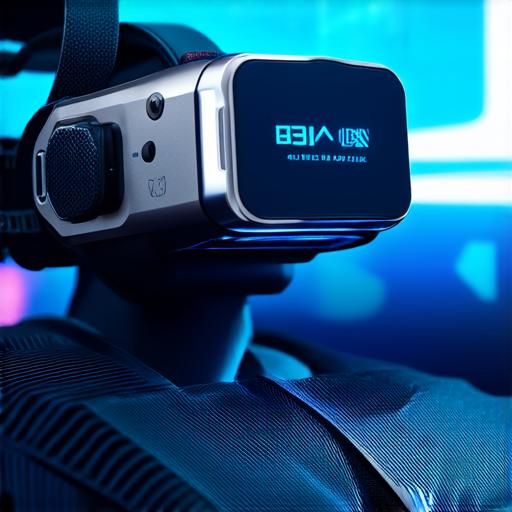Virtual reality (VR) technology has been increasingly popular in recent years, with applications ranging from gaming to healthcare and tourism. However, like any new technology, there are risks associated with its use that need to be addressed to ensure the safety of users. In this article, we will explore the potential risks and benefits of VR technology, as well as strategies that developers can implement to ensure safe use of their virtual worlds.
Risks Associated with VR Technology
-
Motion sickness: One of the most common risks associated with VR is motion sickness, which occurs due to the disconnect between what the user sees and feels in real life. This can lead to nausea, dizziness, and headaches. According to a study by researchers at the University of Maryland, approximately 40% of users experience motion sickness when using VR technology.
-
Eye strain: VR headsets require users to keep their eyes fixed in one direction for extended periods, which can lead to eye strain, dryness, and irritation. This can cause discomfort and even headaches. A study by researchers at the University of Sussex found that users who spent more than two hours using VR headsets experienced a 20% increase in eye strain.
-
Physical injury: VR technology can be used for physical activities such as sports, dance, and fitness. However, users may not have the same level of awareness or control as they do in real life, which can lead to physical injury. According to a report by the Consumer Product Safety Commission (CPSC), between 2016 and 2018, there were 23 incidents related to VR headsets that resulted in injuries.
-
Addiction: VR technology can be highly immersive, which can lead to addiction and withdrawal symptoms when the user is unable to access it. A study by researchers at the University of California, Irvine found that users who spent more than two hours using VR technology were 5% less productive the next day compared to non-users.

Benefits of VR Technology
-
Improved cognitive function: VR technology can be used for cognitive training exercises that simulate real-life scenarios, which can improve problem-solving and decision-making skills. According to a study by researchers at the University of California, San Francisco, VR technology was found to be as effective as traditional in-person training in improving cognitive function.
-
Enhanced learning experiences: VR technology can provide students with immersive learning experiences that allow them to explore and interact with virtual environments in a safe and controlled manner. This can enhance their understanding of complex concepts and improve their retention of information. According to a study by researchers at the University of Maryland, using VR technology for learning resulted in a 40% increase in student engagement compared to traditional classroom settings.
-
Reduced anxiety and phobias: VR technology can be used to treat anxiety disorders such as PTSD, social anxiety, and specific phobias by exposing patients to controlled virtual environments that simulate real-life situations. According to a study by researchers at the University of Oxford, VR therapy was found to be as effective as traditional talk therapy in reducing anxiety levels in patients with PTSD.
-
Pain management: VR technology can be used to distract patients from pain and improve their overall comfort during medical procedures. According to a study by researchers at the University of California, San Francisco, VR technology was found to be effective in reducing pain levels and anxiety in patients undergoing surgery.
-
Improved social skills: VR technology can be used to simulate real-life social situations, allowing people to practice and improve their social skills in a safe and controlled environment. This can be particularly beneficial for people who have difficulty with social interaction or those who are struggling with certain types of social anxiety.
Strategies for Ensuring Safe Use of VR Technology
-
Design for comfort: Developers must take steps to ensure that their virtual worlds are comfortable and easy to use, especially for people with certain medical conditions or those who are prone to motion sickness. This can include using comfortable headsets, adjusting the brightness and contrast settings, and providing clear instructions on how to navigate the virtual environment.
-
Provide clear instructions: Developers must provide clear instructions on how to use their VR technology, including how to adjust the settings, how to control movements, and how to avoid potential risks or negative consequences. This can include providing detailed manuals, tutorials, and video guides.
-
Conduct user testing: Developers must conduct user testing to gather feedback from users on the comfort level of the headset, the effectiveness of the software, and any potential risks or negative consequences associated with its use. This can help developers identify areas for improvement and make necessary adjustments to ensure safe use of their VR technology.
-
Continuously monitor usage: Developers must continuously monitor usage of their VR technology to ensure that it is being used safely and responsibly. This can include limiting screen time, providing breaks, and updating software to address any bugs or glitches.
-
Follow industry standards: Developers must follow industry standards for designing and testing VR technology to ensure that it is safe for users. This can include obtaining certification from organizations such as the International Organization for Standardization (ISO) or the Occupational Safety and Health Administration (OSHA).
Summary
Virtual reality technology has the potential to provide numerous benefits, but it is important to address the risks associated with its use. Developers must take steps to ensure that their virtual worlds are safe for users by designing for comfort, providing clear instructions, conducting user testing, continuously monitoring usage, and following industry standards.
By doing so, we can harness the power of VR technology while minimizing any potential risks or negative consequences. It is important for both developers and users to be aware of the potential risks and take necessary precautions to ensure safe use of VR technology.
